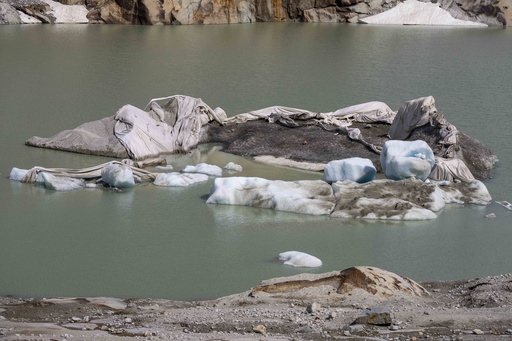A comprehensive recent study highlights the significant effects of climate change on the world’s mountain glaciers, revealing that they are diminishing at more than twice the rate compared to the early 2000s.
From 2000 to 2011, glaciers lost ice at an annual rate of approximately 255 billion tons (231 billion metric tons). However, this rate increased to around 346 billion tons (314 billion metric tons) annually over the subsequent decade. The latest analysis shows an alarming peak of 604 billion tons (548 billion metric tons) of ice lost in 2023, the last year examined in the study published in the journal Nature.
Conducted as part of a global collaboration that incorporated 233 measures of glacier mass change, the research found that glaciers around the world have shed more than 7 trillion tons of ice (6.5 trillion metric tons) since the start of the millennium.
William Colgan, a glaciologist with the Geological Survey of Denmark and Greenland and a contributor to the study, expressed concern over the accelerated retreat of glaciers. “People should recognize that glaciers are indeed receding, and the speed of that loss appears to be increasing,” he remarked.
The study indicates that glaciers in Alaska are experiencing the most rapid melting among the 19 regions analyzed, with an ice loss of approximately 67 billion tons (61 billion metric tons) yearly, representing the most significant net loss.
Additionally, glaciers in Central Europe have witnessed the steepest percentage decline in ice volume over the past two decades, now measuring 39% smaller than they were in 2000. Colgan particularly noted the Alps as being at risk due to increased summer temperatures having a severe impact on these glaciers.
Historically, scientists voiced concerns about glaciers in the Andes and Patagonia, but given the rapid shrinkage of the Alps, there are fears they could eventually vanish entirely.
Gwenn Flowers, a professor of Earth Sciences at Simon Fraser University in Canada, emphasized the unpartisan nature of glaciers as indicators of climate change, stating, “Their decline provides a vivid illustration of accelerated warming.”
Ted Scambos, an ice scientist at the University of Colorado, highlighted the distinction between past glacier fluctuations and present conditions. He asserted that the current accelerated melting is driven by greenhouse gas emissions linked to fossil fuel combustion: “The situation today is starkly different, and no amount of debate will alter this reality.”
Both Scambos and Flowers, along with other external experts, described the study’s findings as sobering yet predictable. Colgan noted that while regions like the western U.S. are currently benefiting from melting glaciers providing additional water, this advantage is temporary and will vanish once the glaciers melt past a critical threshold.
Notably, melting glaciers are contributing more to rising sea levels than the combined ice loss from Greenland and Antarctica. Only the warm expansion of water contributes a larger impact to sea level rise, as outlined in the study.
The current glacier loss rate, while on par or perhaps slightly lower than previous research, is expected to prompt revised predictions that could reflect an even bleaker outlook due to both improved data and escalating global warming patterns. Colgan asserts, “Losing 5.5% of global ice volume in just over two decades is clearly unsustainable and will have repercussions.”
He further commented, “The figure of over 600 billion tons of ice loss in 2023 is shocking now; however, it may become commonplace in a decade.” He highlights the potential for mountain glaciers to transition into rapid mass loss remarkably quickly.
